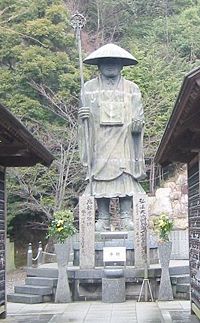Sarvastivada
From Buddha World
Sarvastivada is an early school of Buddhism that held to 'the existence of all dharmas in the past, present and future, the 'three times'. The Abhidharma Kosa-bhaṣya, a later text, states:
- "25c-d. He who affirms the existence of the dharmas of the three time periods [past, present and future] is held to be a Sarvastivadin."
Philosophy
Though the sarvastivadins would themselves claim that their teaching of ‘all exists’ (sarvasti) is a direct teaching of the Buddha himself, as shown by their attributing the earliest abhidharma texts to direct disciples of the Buddha, notably to Sariputra and constant reference to the sutras throughout, the school in its entirety is more rightly to be considered as part of the age of scholastic Buddhism. It was the most influential school in the northwestern part of India. In a Chinese context, the word abhidharma refers to the sarvastivada abhidharma, although Dharmaguptaka and Pudgalavada also had an abhidharma. During the first century BC, in the Gandharan cultural area (consisting of Oddiyana, Gandhara and Bactria, Tokharistan, across the Khyber Pass), the sthaviriyas used Gandhari to write their literature in Kharoṣṭhī. During this time, the sarvastivada abhidharma primarily consisted of the Abhidharmahrdaya authored by Dharmashresthin, a native from Tokharistan, and the Ashtagrantha authored/compiled by Katyayaniputra. Both texts were translated by Samghadeva in 391 A.D. and in 183 A.D. respectively, but they were not completed until 390 in Southern China. Although the sarvastitva was the central thesis, there were different theories on how ‘sarvam’ and even ‘asti’ were actually to be explained and understood among the Gandharan diverse sarvastivadins. Vasubandhu’s Koshabhasya, an elaborate yoga manual based on the Hrdaya, describes four main theses on sarvasti: ‘There are four types of sarvastivadins accordingly as they teach a difference in existence (bhavanyathatva), a difference in characteristic (laksananyathatva), a difference in condition (avasthanyathatva), and mutual difference (anyonyathatva). Later sarvastivada takes a combination of the first and third theses as its model. It was on this basis that the school’s doctrines were defended in the face of growing external, and sometimes even internal, criticism. The doctrines of sarvastivada were not confined to ‘all exists’, but also include the theory of momentariness (ksanika), conjoining (samprayukta) and simultaneity (sahabhu), conditionality (hetu and pratyaya), the culmination of the spiritual path (marga), and others. These doctrines are all inter-connected and it is the principle of ‘all exists’ that is the axial doctrine holding the larger movement together when the precise details of other doctrines are at stake. The sarvastivada was also known by other names, particularly hetuvada and yuktivada. Hetuvada comes from hetu – ‘cause’, which indicates their emphasis on causation and conditionality. Yuktivada comes from yukti – ‘reason’ or even ‘logic’, which shows their use of rational argument and syllogism. When the sarvastivada school held a synod in Kashmira during the reign of Kanishka II (ca. 158-176), the Gandharan most important text, the Astagrantha of Katyayaniputra was rewritten in Sanskrit making necessary revisions. This revised text was now known as Jbanaprasthana, Course of Knowledge. Though the Gandharan Astagrantha had many vibhasas, the new Kashmira Astagrantha i.e. the Jnanaprasthana had a Sanskrit Mahavibhasa, compiled by the Kashmira sarvastivada synod. The Jnanaprasthana and its Mahavibhasa, which took more than a generation to complete, were then declared the Vaibhasika orthodoxy, said to be ‘Buddha’s word’, Buddhabhasita. This new Vaibhasika orthodoxy, however, was not readily accepted by the Gandharan sarvastivadins, though gradually they adapted their views to the new Kawmira orthodoxy. The Gandharan sarvastivadins used the same Vinaya from Mathura. As a matter of fact, their abhidharma was meant for meditational practices. They made use of the Hrdaya which is a manual for attaining arhat. However, the long Gandharan Vinaya was abridged to a Sanskrit Dashabhanavara in the Kashmira synod by removing the avadanas and jatakas, stories and illustrations. After the declaration of the Vaibhasika orthodoxy, the Gandharan non-vaibhasika sarvastivadins, the majority, were called ‘sautrantikas’(those who uphold the sutras) . Interestingly, the Kawmira orthodoxy, the Vaibhasikas disappeared in the later part of the 7th century. Subsequently, the old Gandharan sarvastivadins, the non-vaibhasika sautrantikas, were named ‘mulasarvastivadins’, who then at a later went to Tibet. It has been suggested that the minority Vaibhasikas were absorbed into the majority sautrantika sarvastivadins as a possible result of the latter’s adaptations. Moreover, Mishrakabhidharmahrdaya, a title which means that ‘sautrantika views were mixed with vaibhasika views’ was composed by Dharmatrata in the 4th century in Gandharan area. Vasubandhu (ca.350-430), a native from Purusapura in Gandhara, composed his Kowa based on this text and the Astagrantha. While in Kawmira, he wrote his karikas which were well received there but he faced intense opposition, notably from Samghabhadra, a leading sarvastivada pundit, when he composed his bhasya. By his bhasya, Vasubandhu made it clear to the Vaibhasikas that he was a sautrantika, which is why he was fiercely opposed by the sarvastivada vaibhasikas in Kawmira. In reply to Vasubhandhu’s bhasya, Samghabhadra wrote a text, the Nyananusara ‘according to reason’. This work is presently only extant in Chinese (from Xuanzang’s translation and little is known of it in English). For a critical examination of the Sarvastivadin interpretation of the Samyuktagama, see David Kalupahana, Causality: The Central Philosophy of Buddhism. For a Sautrantika refutation of the Sarvastivadin use of the Samyuktagama, see Theodore Stcherbatsky, The Central Conception of Buddhism and the Meaning of the Word Dharma.
Texts of the Sarvastivada Abhidharma
The Sarvāstivāda Abhidharma consists of seven texts. The texts of the Sarvāstivādin Abhidharma are:
- Sangitiparyaya ('Discourses on Gathering Together')
- Dharmaskandha ('Aggregation of Dharmas')
- Prajnaptisastra ('Treatise on Designations')
- Dhatukaya ('Body of Elements')
- Vijnanakaya ('Body of Consciousness')
- Prakaranapada ('Exposition')
- Jnanaprasthana ('Foundation of Knowledge')
Following these, are the texts that became the authority of the Vaibhasikas, the Kasmiri Sarvastivada Orthodoxy:
- Mahavibhasa ("Great Commentary", on the Jnanaprasthana)
Little research in English has been made in these texts.

 По-Русски
По-Русски
